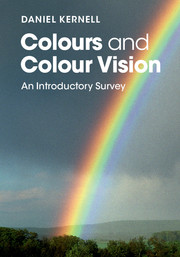Book contents
- Frontmatter
- Dedication
- Contents
- List of plates
- List of figures
- List of tables
- Preface
- 1 Colour vision in everyday life
- 2 The signals of colours: light and wavelengths
- 3 Colours and viewing conditions: not only local wavelengths
- 4 Our biological hardware: eye and brain
- 5 Eyes with unconventional properties: the ‘red-green blinds’
- 6 Other kinds of unconventional colour vision
- 7 Colour vision in different species of animals
- Appendices
- Notes
- References
- Index
- Plate section
7 - Colour vision in different species of animals
Published online by Cambridge University Press: 05 March 2016
- Frontmatter
- Dedication
- Contents
- List of plates
- List of figures
- List of tables
- Preface
- 1 Colour vision in everyday life
- 2 The signals of colours: light and wavelengths
- 3 Colours and viewing conditions: not only local wavelengths
- 4 Our biological hardware: eye and brain
- 5 Eyes with unconventional properties: the ‘red-green blinds’
- 6 Other kinds of unconventional colour vision
- 7 Colour vision in different species of animals
- Appendices
- Notes
- References
- Index
- Plate section
Summary
For a better understanding our own visual capacities and our perception of colours, it is highly interesting to know what properties such functions have in other animals and how they emerged during evolution. Furthermore, for the general understanding of the behaviour and ecology of animals, it is in itself essential to consider the functions of their visual systems, including their colour vision.
Methods for comparative studies of (the capability for) colour vision
There are two main techniques available for studying colour vision capabilities in animals:
Behavioural experimental methods can be used for finding out how well an animal might distinguish different hues and levels of saturation. This is usually done such that the animal gets some attractive reward (piece of food or drink) if it makes a correct choice between a number of different colours. For instance, the food might be hidden behind one out of several panels, all painted in suitably different colours. If the animal pushes or taps on the correct panel, it receives the reward. When testing for the recognition of colour hues, it is important to take care that the animal cannot use any other clues, i.e. the hue must be recognized independently of the lightness and saturation of the target colour. Such behavioural methods are time consuming, partly because they typically require an extended period of training before the animal learns what it is supposed to do. However, with patience and resolve, these techniques may deliver very detailed information about many aspects of the animal's sensory perceptions, e.g. which wavelengths and wavelength combinations may be distinguished from each other. Furthermore, with suitable adaptations, these methods are applicable to practically any species of animal; they have, for instance, been successfully used for studies of honey bees.
Physiological and anatomical/biochemical experimental methods can be used to investigate the functional properties of the sensory machinery available for colour vision. For instance, the reactions of the eye and its receptor cells may be measured while being stimulated with light of different wavelengths. With regard to colour vision it is then of particular interest to find out how many different types of receptor cells there are in the eye (e.g. kinds of cones and rods) and in roughly which relative proportions they occur.
- Type
- Chapter
- Information
- Colours and Colour VisionAn Introductory Survey, pp. 178 - 193Publisher: Cambridge University PressPrint publication year: 2016



